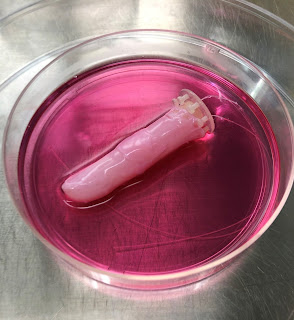Scientists craft living human skin for robots
Jun 2022, phys.org
Robotic finger skin-like texture with water-repellent and self-healing functions.
"The finger looks slightly 'sweaty' straight out of the culture medium,""Since the finger is driven by an electric motor, it is also interesting to hear the clicking sounds of the motor in harmony with a finger that looks just like a real one."
Interesting? Sounds like the deepest horrors of mankind to me.
"With that method, you have to have the hands of a skilled artisan who can cut and tailor the skin sheets," says Takeuchi. "To efficiently cover surfaces with skin cells, we established a tissue molding method to directly mold skin tissue around the robot, which resulted in a seamless skin coverage on a robotic finger."
Skin Sheets.
When wounded, the crafted skin could even self-heal like humans' with the help of a collagen bandage, which gradually morphed into the skin and withstood repeated joint movements.
It heals itself.
"I think living skin is the ultimate solution to give robots the look and touch of living creatures since it is exactly the same material that covers animal bodies," says Takeuchi.
And there you have it.
via University of Tokyo: Shoji Takeuchi, Living skin on a robot, Matter (2022). DOI: 10.1016/j.matt.2022.05.019
Image credit: Robotic finger covered with human living skin self heals, Shoji Takeuchi, University of Tokyo, 2022
Post Script - Fingers of Science:
I don't know where this came from, but I am compelled to archive pictures of scientists holding tiny things in between their fingers. Nothing says science like a tiny piece of magic held by disembodied, rubber-gloved fingers, shoved right in front of the camera. Behold the fruits of human exploration:
 |
| Photonic Processor - June Sang Lee University of Oxford - 2022 |
 |
A transducer combining liquid crystal elastomers with a thermoelectrical device provides advantages like active cooling and regenerative energy harvesting for soft robotics. Credit: Soft Machines Lab, Carnegie Mellon University [link] |
 |
| Wearable Thermoelectric Device - Han et al University of Washington Advanced Energy Materials - 2022 |
 |
| SbSI and SbSI-Sb2S3 Photovoltaic Devices - Ryosuke Nishikubo - 2022 |
 |
| hectoSTAR probe - Eunah Ko shows University of Michigan - 2022 |
 |
| Film coated in thermoelectric ink - KTH Royal Institute of Technology - 2022 |
 |
Double whammy, in the wild. |


No comments:
Post a Comment